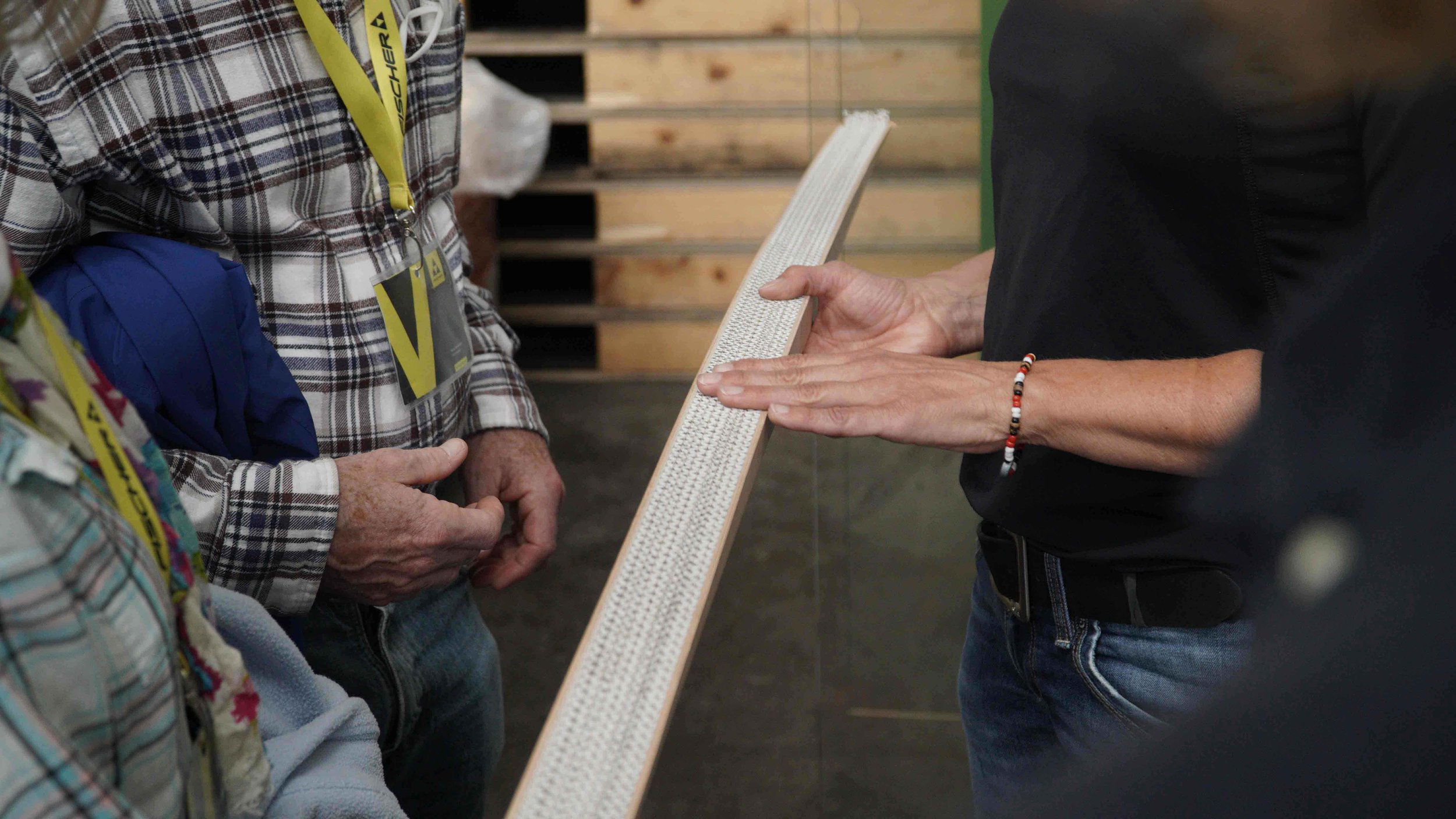The Perfect Pair
As you put storage wax on your skis this spring, have you ever wondered how skis are actually made? Last September, I visited the Fischer and Salomon / Atomic ski factories with our travelers on the Lumi Experiences Factory Tour Trip and learned how skis are produced.
Austria’s rich ski culture, strong manufacturing industry, access to forests for wood and mountains with glaciers for year-round testing make it an ideal place for producing skis. Perhaps this is why three of the biggest ski producers: Fischer, Salomon and Atomic, all have their factories in Austria.
Tanja Winterhalder, Fischer’s Head of Nordic Marketing, shares the impressive history of Fischer skis
For decades, skis were made from wooden planks. Small manufacturers of wooden skis and sleds could be found in valleys throughout the Alps and Scandinavia. In the 1970s, manufacturing and materials technology made it possible to create skis with composites of many different materials. Fischer, based in Ried, Austria, had long produced parts for the airline industry as well as skis. They were a pioneer in transferring knowledge of airplane wing technology to ski production. Super light and strong, the processes in both industries are very complimentary.
At their core, high end skis are identical to airplane wings. Nomex is a honeycomb product known for its high strength to weight ratio, ideal for skis and wings alike--anyone who wants to fly. Sheets of poplar wood panel are glued and pressed to the honeycomb, making what will become the ski’s internal sidewall. The poplar is sourced locally, as the highest quality possible is necessary to keep a consistent shape for the life of the ski.
At this point, the honeycomb-poplar panels look more like something you might use to insulate a house. The panels are then cut into the shape of a ski. As many as 20 skis might come from one panel. The tip and tail of the skis are also added separately. The tips and tails look about as thin as a piece of paper and have no shape.
Skis at the Salomon / Atomic factory are ready for the press.
A metal mold is produced in the factory for each ski model and length. Each ski component is laid into the mold, starting with the base, a thin layer of carbon and another layer that acts like an arch support in a shoe. Next, the honeycomb-wood core is the most important ingredient in the sandwich, followed by another layer of carbon and the graphics on top. The ski in the mold is now ready for the press.
The ski press heats up the mold and components enough to adhere everything together. How are skis given their flex? What makes a ski good for wet, soft or hardpack conditions? This is not random. Before the ski mold goes into the press, one of 36 pressure points can be tuned like a Steinway to create exactly the desired flex for each ski. Seeing this took a lot of the mystery out of ski flex for me. The skis coming out of the mold are laser flex tested to confirm the desired results.
At this point, the product resembles a ski, but is still very rough around the edges. Literally. There is still material and glue coming out of the seams. The ski looks a lot like a sandwich with a few too many ingredients.
To finish the ski, it is sent down what looks like a 100 foot long Rube Goldberg machine for skis. Along the track, the sidewalls are cut and polished, the groove cut out of the middle and the rest of the base is ground to the desired specifications.
At this point, the skis look finished, but there is one more important step. I assumed that the skis that went into the press together would come out as a pair. Surprisingly, even if two skis go into the press together with exactly the same heat and pressure, they do not necessarily have the same flex. One of the most painstaking and important jobs is finding the perfect match for each pair of skis.
At Salomon / Atomic, the factory is shared between the two companies. Many of the processes are similar, but the technology that goes into the skis is a little different. At some points during the tour, I felt like I was walking through the set for the movie Tenet, where red and blue lights coming from different rooms indicated which skis were stored where.
Salomon’s Jean-Marc Draeyer explains the flex numbers for new skin skis coming off the line under the watchful eye of a Jessie Diggins poster.
At the end of the line, the skis are packaged and shipped off to your favorite ski shop.
What is the best ski, I’m often asked? Similar to the painstaking process of perfectly matching two skis to make a pair, finding the best pair of skis is about finding the right match for you. One hint: get in early so you have the best selection. Hopefully these photos help share a little insight into what goes into producing your favorite pair of skis.
The Dachstein Glacier in August 2021, where many of the Austrian skis get tested -- and you can ski there on the Lumi Experiences Factory Tour Trip too!
Want to visit the factories yourself? And get outside to explore the surroundings? Join us for the 2025 Lumi Experiences Factory Tour Trip, where you can visit these factories in person, plus hike in the Alps and ski on the Dachstein Glacier and in the ski tunnel in Planica, Slovenia. Email info@lumiexperiences.com for a detailed itinerary or to sign up!
See you on the trail,
Garrott
Garrott Kuzzy and Jean-Marc Draeyer in Salomon’s race room












